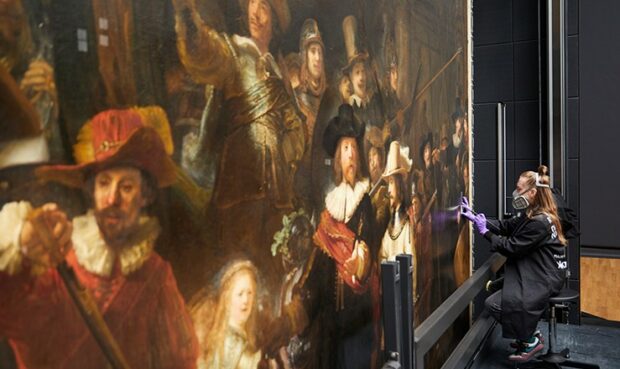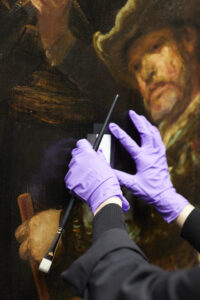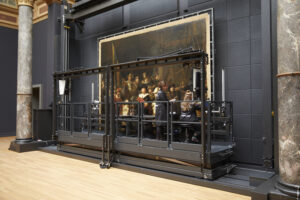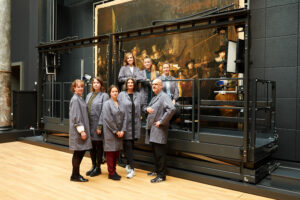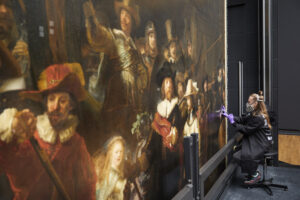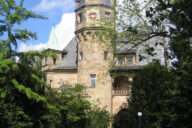Restoration begins of Rembrandt’s The Night Watch
Following five years of intensive research and the re-stretching of the painting, today a team of eight Rijksmuseum conservators started removing the varnish from The Night Watch. This marks the beginning of the second phase of Operation Night Watch, the biggest ever research and restoration project devoted to this masterpiece by Rembrandt. Removing the old varnish will enable us to preserve the painting for future generations. Visitors are able to follow the process live in the Night Watch Gallery, where the restoration work is being carried out with microscopic precision in the see-through glass chamber.
Taco Dibbits, Director of the Rijksmuseum: The start of the restoration phase is filled with anticipation: removing the varnish will expose the eventful history of The Night Watch, and it will be a truly unique experience for the visiting public to be able to follow the process from so close by.
Varnish
Our conservators are using a special type of tissue to remove the varnish layers that were applied to the painting as part of its restoration in 1975-1976. The conservators place the tissue, prepared with a solvent, against the surface of The Night Watch for a short, limited amount of time. The varnish is solubilised and absorbed into the tissue. Then, using a microscope, they carefully remove any remnants of even older varnish with cotton swabs. This moment is the culmination of years of scientific research, applying this technique to other paintings, and conducting tests on The Night Watch itself.
Operation Night Watch
Over the last five years a large team of conservators, curators, scientists and other specialists have studied The Night Watch using the most advanced technologies: from digital imaging to scientific and technical studies, and from computer science to artificial intelligence. This work has led to various breakthroughs in our understanding of the painting’s condition and the artist’s way of working. The team collaborates with experts from the Rijksmuseum’s main partner for this project, AkzoNobel, as well as the Cultural Heritage Agency of the Netherlands (RCE), Delft University of Technology (TU Delft), the University of Amsterdam (UvA), Amsterdam University Medical Centre (AUMC), the University of Antwerp (UA), Vrije Universiteit Amsterdam (VU), Eindhoven University of Technology (TU/e) and the National Gallery of Art, Washington DC. For more information online, please visit Operation Night Watch – Rijksmuseum.
AkzoNobel is the main partner of Operation Night Watch.
Operation Night Watch is made possible by The Bennink Foundation, C.L. de Carvalho-Heineken, PACCAR Foundation, Piet van der Slikke & Sandra Swelheim, American Express Foundation, Familie De Rooij, Het AutoBinck Fonds, TBRM Engineering Solutions, Dina & Kjell Johnsen, Familie D. Ermia, Familie M. van Poecke, Bruker Nano Analytics, Henry M. Holterman Fonds, Irma Theodora Fonds, Luca Fonds, Piek-den Hartog Fonds, Stichting Zabawas, Cevat Fonds, Johanna Kast-Michel Fonds, Marjorie & Jeffrey A. Rosen, Stichting Thurkowfonds, Familie Van Ogtrop Fonds, FedEx Express, Airbnb, NICAS, the Night Watch Fund, the City of Amsterdam and the Amsterdam Museum.
Übersetzung
Nach fünf Jahren intensiver Forschung und der Umspannung des Gemäldes hat heute ein Team von acht Restauratoren des Rijksmuseums begonnen, den Lack von The Night Watch zu entfernen. Dies ist der Beginn der zweiten Phase der Operation Night Watch, dem größten Forschungs- und Restaurierungsprojekt, das Rembrandt diesem Meisterwerk gewidmet ist. Das Entfernen des alten Lacks ermöglicht es uns, das Gemälde für zukünftige Generationen zu erhalten. Die Besucher können den Prozess live in der Night Watch Gallery verfolgen, wo die Restaurierungsarbeiten mit mikroskopischer Präzision in der durchsichtigen Glaskammer durchgeführt werden.
Der Beginn der Restaurierungsphase ist voller Vorfreude: Das Entfernen des Lackes wird die bewegte Geschichte von The Night Watch enthüllen, und es wird ein wirklich einzigartiges Erlebnis für das besuchende Publikum sein, dem Prozess aus der Nähe folgen zu können.
Taco Dibbits, Direktor des Rijksmuseums
Lack
Unsere Restauratoren verwenden eine spezielle Gewebeart, um die Lackschichten zu entfernen, die im Rahmen ihrer Restaurierung in den Jahren 1975-1976 auf das Gemälde aufgetragen wurden. Die Restauratoren legen das mit einem Lösungsmittel vorbereiteten Gewebe für kurze, begrenzte Zeit gegen die Oberfläche der Nachtwache. Der Lack wird egoisiert und ins Gewebe aufgenommen. Dann entfernen sie mit dem Mikroskop sorgfältig alle Reste eines noch älteren Lacks mit Wattestäbchen. Dieser Moment ist der Höhepunkt jahrelanger wissenschaftlicher Forschung, die Anwendung dieser Technik auf andere Gemälde und die Durchführung von Tests auf The Night Watch selbst.
Operation Nachtuhr
In den letzten fünf Jahren hat ein großes Team von Restauratoren, Kuratoren, Wissenschaftlern und anderen Spezialisten The Night Watch mit den fortschrittlichsten Technologien untersucht: von der digitalen Bildgebung bis zur wissenschaftlichen und technischen Studien, von der Informatik bis zur künstlichen Intelligenz. Diese Arbeit hat zu verschiedenen Durchbrüchen im Verständnis des Zustands der Malerei und der Arbeitsweise des Künstlers geführt. Das Team arbeitet mit Experten des Rijksmuseums Hauptpartners für dieses Projekt, AkzoNobel, sowie der Cultural Heritage Agency of the Netherlands (RCE), der Technischen Universität Delft (TU Delft), der Universität Amsterdam (UvA), des Amsterdam University Medical Centre (AUMC), der Universität Antwerpen (UA), der Universität Antwerpen (UA), Vrije Universiteit Amsterdam (VU), der Eindhoven University of Technology (TU/e) und der Nationalgalerie. Weitere Informationen online finden Sie unter Operation Night Watch – Rijksmuseum.
AkzoNobel ist der Hauptpartner von Operation Night Watch.
Operation Night Watch wird von der Bennink Foundation, C.L. de Carvalho-Heineken, PACCAR Foundation, Piet van der Slikke & Sandra Swelheim, American Express Foundation, Familie De Rooij, Het AutoBinck Fonds, TBRM Engineering Solutions, Dina & Kjell Johnsen, Familie D. Ermia, Familie M. van Poecke, Bruker Nano Analytics, Henry M. Holterman Fonds, Irma Theodora Fonds, Luca Fonds, Piek-den Hartog Fonds, Stichting Zabawas, Cevat Fonds, Johanna Kast-Michel Fonds, Marjorie & Jeffrey A. Rosen, Stichting Thurkowfonds, Familie Van Ogtrop Fonds, FedEx Express, Airbnb, NICAS, der Nachtuhrfonds, die Stadt Amsterdam und das Amsterdamer Museum.

